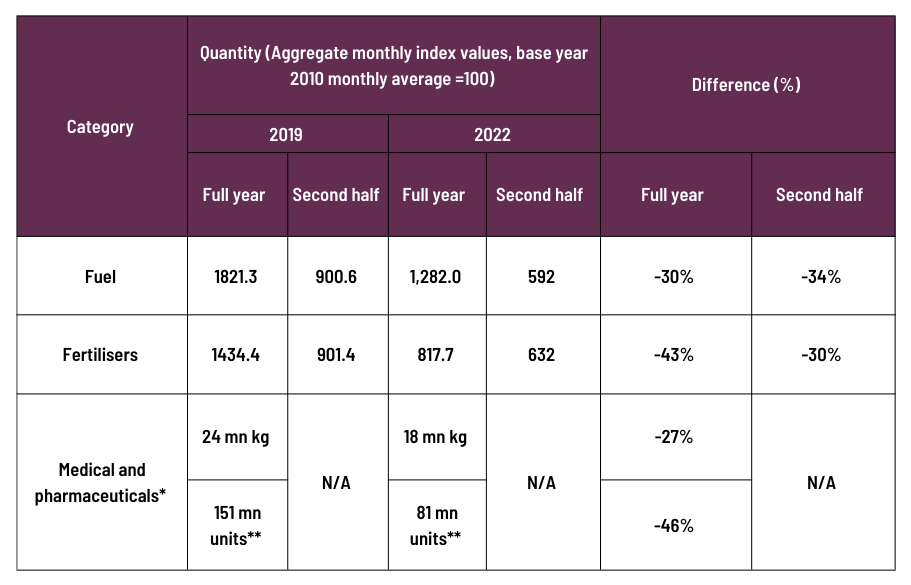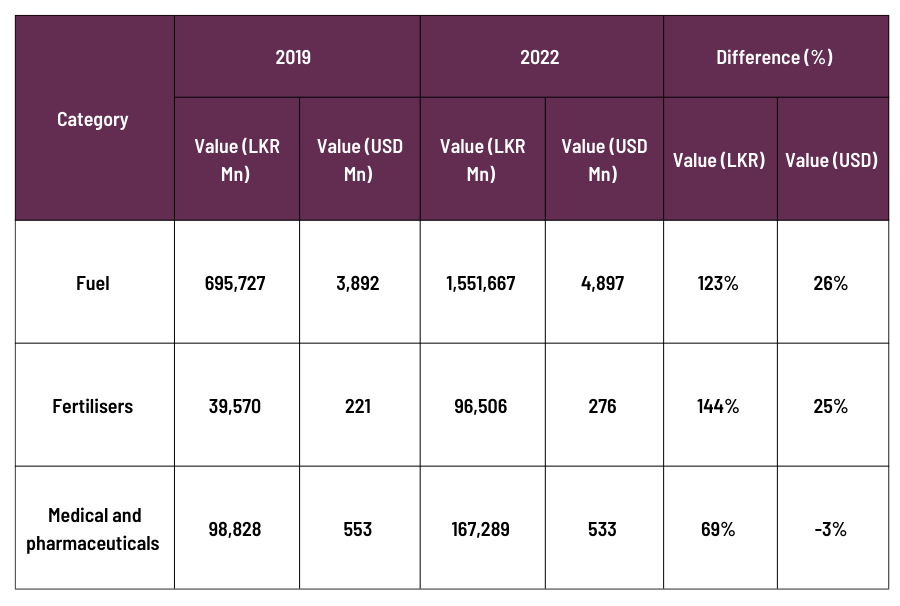Fact Check
The state minister claims that fuel, medicine, and fertiliser are being imported without a shortage.
To check this claim, FactCheck.lk consulted statistics from the Export Development Board and the Central Bank of Sri Lanka.
FactCheck.lk used the quantity of imports in 2019 as the base year to assess if the quantity imported in 2022 might be with or without a shortage. Quantities were compared for the full year as well as the last six months. 2019 was selected as the base (normal) year as it was the first year that precedes the economic crisis and the covid-19 pandemic. To import without shortages is evaluated as having kept up to at least 90% of the import levels of the base year (allowing for a demand reduction similar to the reduction in real GDP, which fell by 8.9% from 2019 to 2022).
Exhibit 1 shows that for the full year the quantities of fuel and fertiliser fell by 30% and 43% in 2022. For the second half of the year, it fell by 34% and 30%, respectively. For medical and pharmaceutical items, for the full year, imports fell by 27% for items counted by weight and 46% for items counted in numbers (half-yearly data was not available).
Compared to 2019, there is a severe reduction in the importation of the quantity of all three products in 2022 – ranging from a 27% to a 46% reduction. This implies a huge shortage of supply relative to the expected demand, even after adjusting demand expectations downwards in line with the reduction in real GDP.
Therefore, we classify the state minister’s statement as FALSE.
*FactCheck.lk’s verdict is based on the most recent information that is publicly accessible. As with every fact check, if new information becomes available, FactCheck.lk will revisit the assessment.
Exhibit 1: Change in quantity (Full year and half year comparison between 2019 and 2022)

Sources: Export Development Board and the Central Bank of Sri Lanka data
* For medical and pharmaceuticals, the quantity is reflected in units as its not available as an index.
**For HS codes 900130, 900140,901831,901839,902140,902150 the quantity is denoted in number of units as opposed to the weight (kg).
Exhibit 2: Change in value (Full year comparison)

Sources: Export Development Board and the Central Bank of Sri Lanka data
Additional Note
Exhibit 2 shows that despite the drastic reduction in quantities the cost in USD terms has reduced less, or even increased in these product categories. This points to import orders being made at a very much higher USD cost in 2022. Evaluating only the cost of imports can give a misleading sense that there is little or no shortage; Whereas the quantity level data analysed in this fact check suggests that there is a severe shortage.
Sources
Central Bank of Sri Lanka, External Statistics, Available at; https://www.cbsl.gov.lk/en/statistics/statistical-tables/external-sector [Last accessed 22 February 2023]
Export Development Board, Trade Statistics, Available at; https://stat.edb.gov.lk/ [Last accessed 22 February 2023]
International Monetary Fund, “IMF Staff Reaches Staff-Level Agreement on an Extended Fund Facility Arrangement with Sri Lanka”, 1 Sep 2022. Available at; https://www.imf.org/en/News/Articles/2022/09/01/pr22295-imf-reaches-staff-level-agreement-on-an-extended-fund-facility-arrangement-with-sri-lanka [Last accessed 22 February 2023]
Ministry of Finance, Sri Lanka Investor Presentation, Available at; https://www.treasury.gov.lk/api/file/20adcaf7-874b-48da-9bc2-69240015cd7c [Last accessed 22 February 2023]


